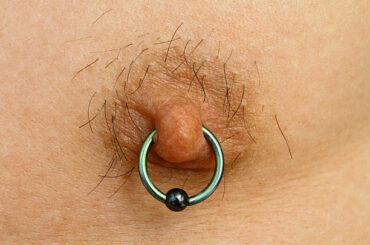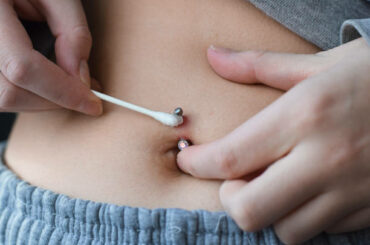Bridge piercings have gained popularity as a trendy form of facial piercing. This unique style involves inserting jewelry through the bridge of the nose, creating a striking and eye-catching look. However, it’s important to know that scarring can be a potential issue associated with bridge piercings. While many individuals successfully adorn this piercing without complications, it’s essential to understand the factors that can contribute to scarring and how to prevent or address it. In this article, we will explore the art of bridge piercings while addressing the potential concern of scarring and providing guidance on minimizing its occurrence.
Contents
Causes of Bridge Piercing Scars
Scarring can occur with bridge piercings due to various factors. Understanding these causes can help individuals make informed decisions and take appropriate measures to minimize the risk of scarring. Here are the primary causes to be aware of:
1. Improper Piercing Technique:
One of the leading causes of scarring is improperly performed bridge piercing. If the piercing is not done by a professional piercer using sterile equipment and following proper techniques, it can increase the likelihood of scarring.

2. Infection:
Infections are another significant factor that can lead to scarring. If proper aftercare instructions are not followed, or the piercing becomes contaminated, bacteria can enter the wound, causing an infection. If left untreated or not managed promptly, infections can contribute to scar tissue formation.
3. Trauma and Irritation:
Excessive trauma or irritation to the piercing site can also result in scarring. This can occur due to accidental pulling or tugging on the jewelry, applying excessive pressure, or using inappropriate cleaning agents. Such trauma or irritation can disrupt the healing process and lead to the formation of scars.
By understanding these causes, individuals considering or already having a bridge piercing can take preventive measures and adopt proper aftercare practices to minimize the risk of scarring.
Preventing Bridge Piercing Scars
While scarring is a potential concern with bridge piercings, there are several proactive steps individuals can take to reduce the likelihood of scarring. By following these preventive measures, you can promote optimal healing and minimize the risk of scarring.
1. Choosing a Professional Piercer:
Selecting a skilled and experienced professional piercer is crucial. Ensure that the piercer follows strict hygiene practices, uses sterilized equipment, and has a solid reputation for performing successful piercings. A professional piercer will have the necessary expertise to minimize the risk of complications, including scarring.
2. Proper Aftercare Instructions:
Adhering to proper aftercare instructions is vital for the healing process and reducing the chances of scarring. Follow your piercer’s specific guidelines, typically cleaning the piercing with a saline solution and avoiding touching it with unwashed hands. Additionally, refrain from using harsh cleaning agents or products that can irritate the piercing site.
3. Being Mindful of Jewelry:
Selecting suitable jewelry for your bridge piercing can help prevent irritation and minimize the risk of scarring. Opt for high-quality jewelry made from surgical steel or titanium, known for its hypoallergenic properties. Avoid changing or removing the jewelry before the piercing has fully healed, as this can disrupt the healing process and increase the risk of scarring.
By choosing a professional piercer, following proper aftercare instructions, and being mindful of the jewelry you wear, you can significantly reduce the chances of scarring and promote a successful healing process for your bridge piercing. Remember, taking proactive steps and seeking professional advice can contribute to a positive piercing experience.
Treating Bridge Piercing Scars
If you already have a bridge-piercing scar that concerns you, various treatment options are available to improve its appearance. Seeking professional advice from a dermatologist or an experienced piercer is recommended to assess the scar and determine the most suitable course of action. Here are some common treatments for bridge piercing scars:
1. Seeking Professional Advice:
Consulting a professional who specializes in scar treatments is essential. They can evaluate the scar and provide personalized recommendations based on its severity, type, and individual factors. Their expertise will ensure you receive appropriate treatment options.

2. Topical Treatments:
Certain creams, gels, or ointments specifically for scar reduction can be applied topically to the affected area. These products often contain silicone, vitamin E, or other scar-healing compounds. Regular application can help soften and fade the appearance of the scar over time.
3. Silicone Sheets:
Silicone sheets are another non-invasive option for treating bridge-piercing scars. These sheets are applied over the scarred area, providing constant pressure and moisture. This helps flatten and soften the scar tissue, leading to an improved appearance over time.
4. Corticosteroid Injections:
For raised or hypertrophic scars, corticosteroid injections may be recommended. These injections help reduce inflammation and shrink the scar tissue, resulting in a flatter and less prominent scar.
5. Laser Therapy:
Laser therapy is a popular treatment option for various scars, including bridge-piercing scars. Laser treatments target the scar tissue, stimulating collagen remodeling and reducing the appearance of the scar.
6. Surgical Scar Revision:
In more severe cases, surgical scar revision techniques may be considered. This involves surgically removing the scar tissue and repositioning the surrounding skin for a more cosmetically pleasing outcome. However, it’s important to note that this is a more invasive option and should be discussed thoroughly with a professional before considering it.
Conclusion
Bridge piercings can be a stylish and unique form of self-expression, but it’s important to be aware of the potential risk of scarring. By understanding the causes of bridge piercing scars and taking preventive measures, such as choosing a professional piercer, following proper aftercare instructions, and being mindful of jewelry, you can minimize the likelihood of scarring.
However, seeking professional advice is crucial if you already have a bridge-piercing scar that concerns you. A dermatologist or experienced piercer can assess the scar and provide tailored recommendations for scar treatment options. Various options are available to improve the appearance of bridge-piercing scars, from topical treatments and silicone sheets to corticosteroid injections, laser therapy, and surgical scar revision.
It’s essential to emphasize the importance of proper piercing technique and diligent aftercare to reduce the risk of scarring from the outset. By selecting a skilled professional and following their aftercare instructions, you can support the healing process and promote optimal outcomes.

If you have concerns about an existing bridge-piercing scar, don’t hesitate to seek professional help. Professionals can provide expert guidance and develop a personalized treatment plan based on your specific scar characteristics and individual needs. Everyone’s healing journey, and treatment response can vary, so seeking professional assistance ensures the best possible outcome for addressing bridge-piercing scars.
More Posts :
Kirituhi: Exploring the Timeless Beauty of Maori Art in Contemporary Society (2023)
Exploring the fascinating world of Shadbase piercings in 2023
The Rise of Board Game Tattoos: Embracing Personal Expression in 2023





